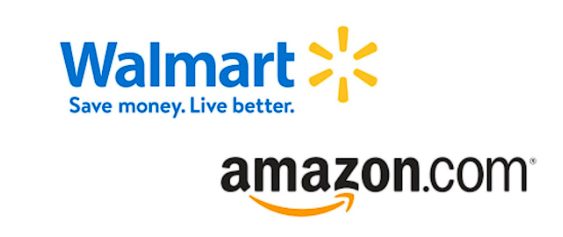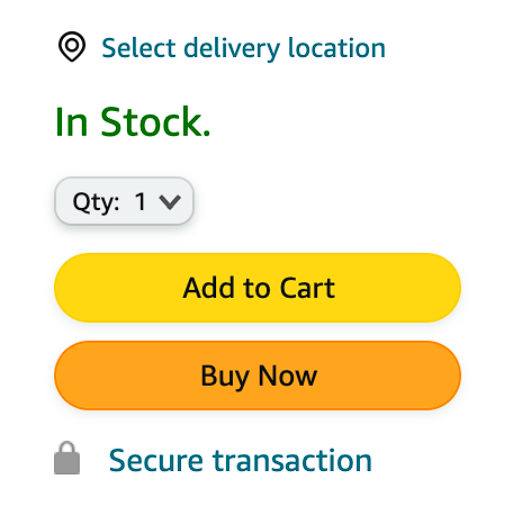
For years, Amazon has dominated the ecommerce space for both buyers and sellers. But other retailers, like Walmart, are gaining market share as they grow their digital storefronts in an effort to compete with the e-commerce giant.
This means third-party sellers now have more options when choosing which platforms and marketplaces to sell their products. Fulfillment options, advertising capabilities, and customer support services are just a few factors sellers need to consider when deciding where to focus their ecommerce efforts to get the greatest return.
So should you sell on Walmart, Amazon, or both? In this article, we provide a comprehensive comparison of both platforms so you can choose the best marketplace for your business.
Table of Contents
Selling on Walmart vs Amazon: A Comparison
Customers often compare Walmart and Amazon, as they are two of the top online marketplaces. In this section, we divide into some key factors to compare when looking for an ecommerce marketplace to work with.
eCommerce Retail Market Share
Amazon and Walmart both contribute to the ecommerce retail market in the U.S., but to varying degrees.
Amazon
Amazon accounted for 37.8% of the U.S. ecommerce retail market in June 2022, making it the undisputed leader in the category. Amazon’s dominance in the space is likely to continue as it has the advantage over traditional retailers experiencing a significant decline in brick-and-mortar sales.
Walmart
Walmart was accountable for 6.3% of the U.S. ecommerce market in June 2022, putting it in second place behind Amazon in ecommerce sales. The company quickly grew its ecommerce presence during the pandemic and with ample facilities and technological resources, Walmart is in a good position to continue gaining market share in the years to come.
Customer Base
An ecommerce platform’s consumer base drives product sales and is an important statistic to consider when deciding where to sell.
Amazon
As of 2022, Amazon’s consumer base consists of over 197 million monthly active users. They also had 2.45 billion unique monthly visitors in 2021, which is more than double the next most popular ecommerce marketplace. With nearly 70% of American adults being Amazon Prime members, Amazon has succeeded in securing a massive base of loyal customers across the country.
Walmart
Walmart’s customer base is also large, but doesn’t come close to Amazon’s reach. For example, Walmart received 388.5 million visitors to its website as of March 2022 compared to Amazon’s 2.45 billion monthly visitors in 2021. While Walmart’s website visitors are up 57.7% since the start of the pandemic, it still does not compare to Amazon’s website traffic.
Seller Fees
Amazon and Walmart have different fees businesses need to pay in order to sell on their platforms.
Amazon
Amazon’s seller fees can seem extensive, but they come with helpful tools.
Fees For All Amazon Sellers:
- Subscription Fee: Amazon’s professional seller account costs $39.99 per month and comes with no per-item fees, buy box eligibility, inventory management reports, and more. An Individual account has no monthly subscription fee, but rather, sellers pay $0.99 on each item they sell. This option is only worth it if you sell less than 40 units per month.
- Referral Fees: Amazon’s referral fees vary by category and can be found on their website. Generally, Amazon’s referral fees range from 8 to 15%, but it is important to check their pricing as it coincides with your product category.
- Closing Fees: Closing fees apply to any product in the media category (software, computer games, video games, video game consoles, etc.). The closing fee on media products is an extra $1.80.
- Processing Fees: All Amazon transaction fees consist of a processing fee (changing if it is domestic vs. cross-border) and an authorization fee. The domestic processing fee is 2.9%, while the cross-border processing fee is 3.9%. The authorization fee is a flat rate of $0.30 tacked on to each order.
Additional Fees For FBA Users:
- Fulfillment Fees: Fulfillment fees for FBA users depend on the size and weight of a product. The fees vary from $3.22 for a small standard size product, to $89.98 + $0.83/lb above the first pound. Here you can review the fulfillment fees for each category.
- Returns Fees: When a customer receives a refund for a returned item, FBA sellers pay a per-item return fee. This is typically 15-20% of the item’s listed selling price.
- Monthly Storage Fees: Amazon charges inventory storage fees monthly, based on the daily average volume of your inventory which is measured in cubic feet. The storage fees also change depending on the time of year. They go from $0.87 per cubic foot in January-September to $2.40 per cubic foot in October-December, which is typically a busier time for sales.
- Long-Term Storage Fees: Long-term storage fees activate once your items sit on the shelf for 365 days. After 365 days, the fee you are paying per cubic foot can rise from $.075 to $6.90.
Walmart
Walmart’s seller fees are different from Amazon’s, mainly because they require no annual or monthly seller fee, which sets them apart from other ecommerce marketplaces.
- Referral Fees: You incur a referral fee based on the product you sell through Walmart’s marketplace. Similar to Amazon, Walmart’s referral fees are based on the product category. Fee ranges from 3 to 20% based on the item and the final sale price.
- Fulfillment Fees: Walmart’s fulfillment fees are determined by calculating a base fee determined by weight, then adding another fee for items that fall within the categories of hazardous materials, apparel, items with low retail prices, and oversize items.
- Monthly Storage Fees: Monthly storage fees with Walmart are $0.75 per cubic foot per month January-September. In October-December, that price rises to $1.50 per cubic foot per month.
- Long-Term Storage Fees: Long-term storage fees are $7.50 per cubic foot per month. Read more about Walmart’s fees on their marketplace page.
Onboarding & Launching Product Listings
Here we will compare the differences in onboarding and launching your ecommerce business on Amazon versus Walmart.
Amazon
Once you sign up for an Amazon seller account, you can create an Amazon Store with all your products listed in one place.
By creating an Amazon store, you get your own URL, no competitor advertising, and you can customize it with your own brand name, logo, and design. From there, you can create individual listings manually through Seller Central, or upload bulk product listings with Amazon’s inventory file templates.
You can also use a tool like Sellesta.ai to optimize your product listings for Amazon SEO.
Walmart
In order to begin listing your products on Walmart.com, you need to first verify your business.This requires more documentation than Amazon, but once verified, you can begin setting up your Partner Profile. Once you complete the three-step account setup process, you can set up your product catalog, choose a fulfillment method, and add inventory.
You can decide to either post new products or integrate existing products through the Walmart catalog. Walmart gives you the option to upload items in bulk or individually.
Pricing & Buy Box Competition

In ecommerce marketplaces, many sellers can offer the exact same product. The buy box allows consumers to buy the product from the seller offering the greatest value — a metric determined by several factors including price, positive reviews, and shipping time. Amazon and Walmart’s buy boxes differ in small ways.
Amazon
To win the Amazon buy box you must have a professional seller account. The Amazon buy box is based on an algorithm which considers factors like positive reviews, reliable shipping, and competitive pricing.
Amazon Marketplace has a significant portion of its top sellers in China, so pricing can be competitive and unpredictable. In order for sellers to win the Amazon buy box, they need to continuously do market research and use automatic repricing tools to remain competitive, as well as meet Amazon’s other eligibility criteria.
Amazon’s pricing policy is that any single product or products must have a price that is equal or less than the price of the same item already being sold on Amazon or other sites. This ensures that pricing is fair and reasonable.
Walmart
The Walmart buy box is similar to Amazon’s as they both look at several factors to determine the winner. But Walmart has strict pricing rules and typically awards the buy box to the seller offering the lowest price.
Walmart’s Two Key Pricing Rules:
- Price Parity: Walmart’s price parity rules that you cannot sell your product at a price that is significantly lower than a price from a competing site.
- Price Leadership: This decrees that your price on Walmart cannot be higher than a product’s price on a different platform.
Although Walmart Marketplace is growing, its seller base is domestic and notably smaller than Amazon’s, making the competitions among sellers less intense.
Shipping & Fulfillment
Amazon and Walmart both give you the option to fulfill your orders independently or through their services. However, there are some key differences.
Amazon
Amazon offers two methods for sellers to fulfill orders: Fulfillment by Amazon (FBA) and Fulfillment by Merchant (FBM).
- Fulfillment by Amazon (FBA): FBA is an optional service for sellers to outsource all order fulfillment processes to Amazon. They store, pack, and ship all inventory for an additional fee. Amazon FBA allows sellers to list products through Amazon Prime, which guarantees fast and reliable shipping for customers. It also provides services for returns and customer support inquiries.
- Fulfillment by Merchant (FBM): FBM is where the seller manages and ships their products independently from Amazon using third party delivery services.
FBA calculators are available to help sellers determine if FBA or FBM will be more profitable to their ecommerce business.
Walmart
Similarly to Amazon, Walmart offers self-fulfillment and full-service fulfillment programs for sellers.
- Walmart Fulfillment Services (WFS): This service provides end-to-end fulfillment for sellers. Business owners can store their inventory at facilities within the Walmart fulfillment network and Walmart will package and ship all orders. They also provide services for returns and customer support inquiries.
- Self-fulfill: Sellers must self-fulfill all deliveries and shipments through a third party service.
- Deliverr: Sellers can have their orders shipped by Walmart’s delivery partner, Deliverr.
Walmart Fulfillment Services is in direct competition with Amazon’s FBA program. While it is newer than FBA, it has similar features, including the guaranteed 2-day free shipping.
Performance Standards
In the eyes of Amazon and Walmart, maintaining high customer satisfaction is paramount. To achieve this, both marketplaces hold performance standards for sellers to make sure customers have a seamless shopping experience.
Amazon
Amazon evaluates seller quality by looking at a few key metrics:
- Rate of order defects (ODR) under 1%
- Cancellation rate at or below 2.5% over a 7-day period
- Late deliveries rate at or below 4% over 10-day and 30-day periods
Sellers using FBA don’t have to monitor these metrics as closely since Amazon handles all aspects of order fulfillment. But for sellers using FBM, working with an Amazon marketing agency can help you stay on top of your performance and avoid account suspension.
Walmart
Walmart has performance metrics that are slightly different than Amazon’s:
- Rate of order defects (ODR) under 2% over a 90-day period
- On-time shipment rate above 99%
- Valid tracking rate above 99%
Advertising & Branding Capabilities

Advertising and branding opportunities are critical to expanding your reach and growing your sales as an ecommerce seller.
Amazon
Amazon gives you the opportunity to create an Amazon store, which you can customize with your own branding. This includes your own URL, company name, logo, and store design. An advantage of having an Amazon store is there is no competitor advertising while users are shopping on your page and only your products are listed.
Amazon also offers self-service solutions for sellers to promote their brands, products, and stores through PPC advertising:
- Sponsored product ads
- Sponsored brands ads
- Product display ads
With strong competition on the platform, it can be easy to waste your budget on ineffective ad campaigns. That’s why it’s important for sellers to use an Amazon SEO tool like Sellesta.ai to ensure their ad campaigns target profitable keywords and their product listings are fully optimized.
Walmart
When you join Walmart, you create a Partner Profile which can be customized with your company’s logo and branding. Walmart also offers search and display ads for sellers to promote products on the platform. Amazon is more saturated with advertising, so sellers may see higher conversions with their ad campaigns on Walmart.com
A major difference between Amazon and Walmart’s PPC models comes down to the auction. Amazon has a second-price auction where the winner only pays one cent more than the second highest bid. Walmart on the other hand has a first-price auction where the sellers pay exactly what they bid even if it’s significantly higher than the second bid.
Selling On Walmart vs Amazon FAQs

Can I sell on both Amazon and Walmart?
Yes, you can sell ecommerce on both Amazon and Walmart at the same time. However, you must list your products at the same price on both marketplaces, otherwise you could incur a fee.
Which is more profitable, Walmart or Amazon?
Amazon and Walmart both are profitable marketplaces to sell ecommerce. Although Amazon has a much broader customer base, it also comes with more competition. However, when working with Walmart, you have to make more of an effort to drive shoppers to your page.
It is important to review the features of both marketplaces and decide what is best for your business.
Optimize Your eCommerce Strategy
Amazon and Walmart are two of the most prominent ecommerce platforms today. When deciding which to work with, sellers should consider which platform’s capabilities and programs will best support their business goals.
Managing all the aspects of selling ecommerce can be time consuming, which is why the best entrepreneurs use third-party tools to help with marketing and advertising. Sellesta.ai offers AI-powered tools that allow sellers to generate optimized product listings, conduct competitive research, and more.
Want to boost your ecommerce sales?


